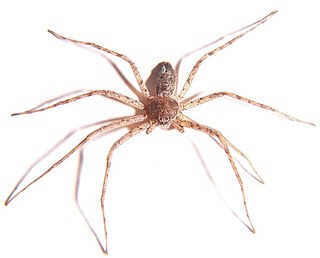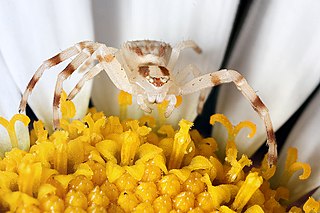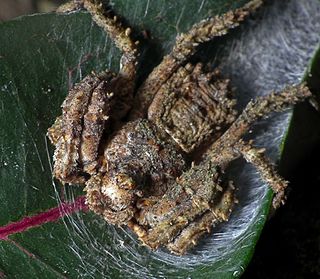
The Thomisidae are a family of spiders, including about 170 genera and over 2,100 species. The common name crab spider is often linked to species in this family, but is also applied loosely to many other families of spiders. Many members of this family are also known as flower spiders or flower crab spiders.

Huntsman spiders, members of the family Sparassidae, are known by this name because of their speed and mode of hunting. They are also called giant crab spiders because of their size and appearance. Larger species sometimes are referred to as wood spiders, because of their preference for woody places. In southern Africa the genus Palystes are known as rain spiders or lizard-eating spiders. Commonly, they are confused with baboon spiders from the Mygalomorphae infraorder, which are not closely related.

Philodromidae, also known as philodromid crab spiders and running crab spiders, is a family of araneomorph spiders first described by Tord Tamerlan Teodor Thorell in 1870. It contains over 500 species in thirty genera.

Misumena vatia is a species of crab spider with a holarctic distribution. In North America, it is called the goldenrod crab spider or flower (crab) spider, as it is commonly found hunting in goldenrod sprays and milkweed plants. They are called crab spiders because of their unique ability to walk sideways as well as forwards and backwards. Both males and females of this species progress through several molts before reaching their adult sizes, though females must molt more to reach their larger size. Females can grow up to 10 mm (0.39 in) while males are quite small, reaching 5 mm (0.20 in) at most. Misumena vatia are usually yellow or white or a pattern of these two colors. They may also present with pale green or pink instead of yellow, again, in a pattern with white. They have the ability to change between these colors based on their surroundings through the molting process. They have a complex visual system, with eight eyes, that they rely on for prey capture and for their color-changing abilities. Sometimes, if Misumena vatia consumes colored prey, the spider itself will take on that color.

Sidymella rubrosignata is a species of crab spiders found in Australia. It is a common spider, often seen on Dianella plants.

Thomisus onustus is a crab spider belonging to the genus Thomisus. These spiders are found across Europe, North Africa, and parts of the Middle East and Asia. T. onustus reside in flowers in lowland vegetation. Females are distinguished by their larger size and ability to change color between white, yellow, and pink as a means of matching flower color. This cryptic mimicry allows them to both evade predators and enhance insect prey capture abilities. Males are smaller, more slender, and drab in coloration, usually green or brown. T. onustus is also distinguished from other relatives by its distinct life cycle patterns in which spiderlings emerge in either late summer or early spring. Furthermore, T. onustus have developed a mutualistic relationship with host plants where spiders feed on and/or deter harmful florivores while benefiting from the plant's supply of pollen and nectar, which T. onustus spiders are able to use as food sources, especially during periods of low insect prey abundance.

Misumenoides formosipes is a species of crab spiders (Thomisidae), belonging to the genus Misumenoides. The species' unofficial common name is white banded crab spider, which refers to a white line that runs through the plane of their eyes. This species is a sit-and-wait predator that captures pollinators as they visit the inflorescences on which the spider sits. The spider has strong front legs which are used to seize prey. The female spider is much larger than the male. The pattern of markings on females is variable and the overall color of the body can change between white and yellow dependent on the color of their surroundings. The color pattern for males, which does not change in their lifetime, differs from females in that the four front legs of males are darker and the abdomen is gold. The spider can be found throughout the United States. Males search for sedentary females within a heterogeneous habitat and guard them until they are sexually mature to reproduce.

The genus Oxytate, commonly known as grass crab spiders, comprises a homogenous group of nocturnal crab spiders. The complete mitochondrial genome of the type species O. striatipes was determined in 2014.

Zygometis is a genus of spider in the family Thomisidae described by Simon in 1901, containing the sole species Zygometis xanthogaster, or the milky flower spider or white flower spider, with a distribution from Thailand to Australia. They are ambush predators.

Cymbacha is a genus of crab spiders that was first described by Ludwig Carl Christian Koch in 1874.
Corynethrix is a monotypic genus of South Pacific crab spiders containing the single species, Corynethrix obscura. It was first described by Ludwig Carl Christian Koch in 1876 based on a female specimen. They have been found in New South Wales and Queensland. A male has not yet been identified, and there is very little known about the biology and behaviour of this species and its relatives.

Hedana is a genus of crab spiders that was first described by Ludwig Carl Christian Koch in 1874.
Australomisidia is a genus of spiders in the family Thomisidae. It was first described in 2014 by Szymkowiak. As of 2017, it contains 8 species, all from Australia.

Bomis is a genus of very small crab spiders, first described by German arachnologist Ludwig Carl Christian Koch in 1874. Five species are currently described, with three species from India and two from Australia.

Thomisus spectabilis, also known as the white crab spider or Australian crab spider, is a small spider found in Australia and far east Asia.

Stephanopis altifrons is a species of crab spider found in Australia. The body length may reach up to 10 and 6 mm in the female and male, respectively. The colour is usually brown, or shades of grey, and sometimes black. The egg sac is 7.5 mm in diameter. Often hidden in crevices of tree bark, it is irregular in shape and camouflaged with the debris. Eggs are off-white, 25 to 30 in number. The female rests with the eggs. The food of this spider appears to be other spiders. Recorded prey include members of the families Salticidae and Hersiliidae.

Cyrtophora hirta is a species of tent spider found in the Australia. The southern range of distribution is near Sydney, though there are New Guinea and Tasmanian records on the Atlas of Living Australia. Ludwig Koch described the species in 1872 from specimens from Bowen, Queensland.

Euryopis splendens is a species of comb-footed spider in the family Theridiidae. The range of distribution is the south east of Australia. The spider lives under stones or bark.

Venatrix furcillata, one of the wolf spiders, is a mid sized spider found in eastern Australia. The body length of the female is up to 13 mm, the male 9 mm. The abdomen has distinctive tapering markings. Sometimes noted in suburban gardens and lawns. It lives in a simple burrow, but may be seen migrating in large numbers to a communal web, an unusual feature for wolf spiders. The grey coloured spherical egg sac is around 6 mm in diameter, carried by the female. Eggs are 45 to 60 in number, 0.8 mm in diameter. Prey is ground dwelling insects. The spider has been identified as occurring in Queensland, New South Wales, and Victoria.

Cymbacha saucia is a crab spider found in Australia. The body length of the female is up to 7 mm, the male 4 mm. A cryptic small species, the colour is usually brown, grey and black. Often found in a folded leaf, used as a retreat.


















